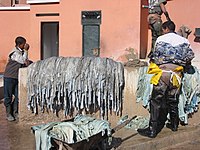
Photo from wikipedia
Water pollution caused by tannery wastewater is an important issue in developing countries. Most studies have focused on inorganic chemicals represented by chromium as a tannery-related main pollutant. This is… Click to show full abstract
Water pollution caused by tannery wastewater is an important issue in developing countries. Most studies have focused on inorganic chemicals represented by chromium as a tannery-related main pollutant. This is the first study in which pollution of water by tannery-related organic chemicals was assessed by a combination of qualitative and quantitative analyses. Our quantitative analysis showed that the maximum concentration of total phenolic compounds (phenols), consisting of phenol, bisphenol F, p-cresol and chlorocresol, in canal water in a tannery built-up area in Bangladesh was >67-fold higher than the Environmental, Health and Safety (EHS) guideline value. Mapping of our results indicated tanneries as the sources of phenols pollution. Our original depurative, a hydrotalcite-like compound consisting of magnesium and iron (MF-HT), could adsorb all kinds of phenols and exhibited the highest phenol adsorption ability (115.8 mg/g) among reported hydrotalcite-like compounds. The levels of phenols in canal water samples were reduced to levels below the guideline value by using MF-HT with assistance of a photocatalytic reaction. Moreover, the mean level of chromium (112.2 mg/L) in canal water samples was decreased by 99.7% by using the depurative. Thus, the depurative has the potential for solving the problem of tannery-related water pollution by phenols and chromium.
Journal Title: Chemosphere
Year Published: 2021
Link to full text (if available)
Share on Social Media: Sign Up to like & get
recommendations!